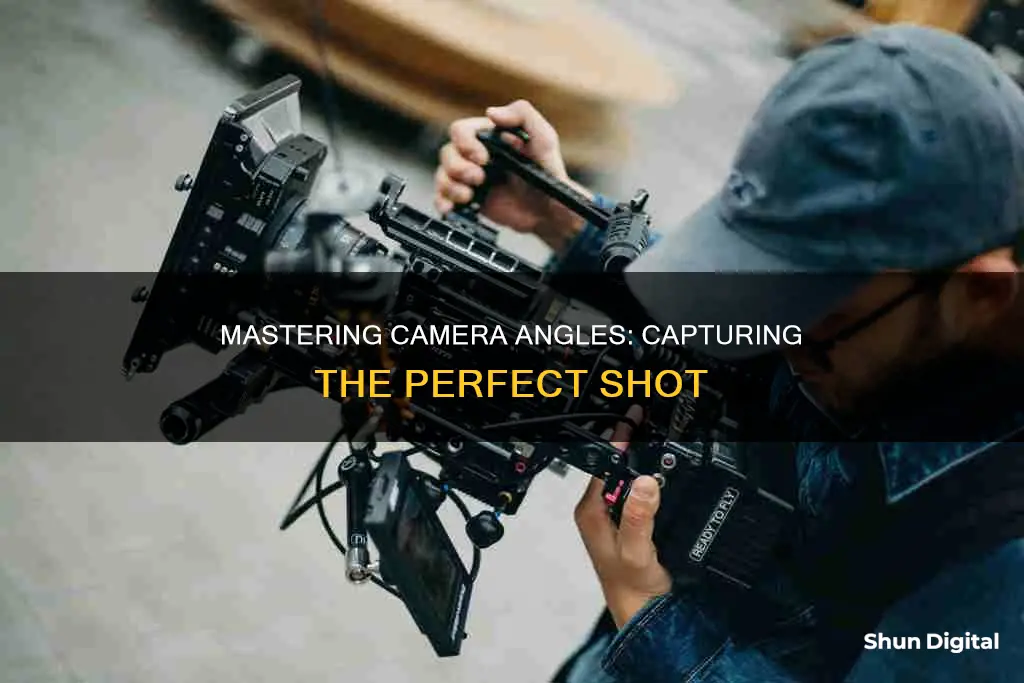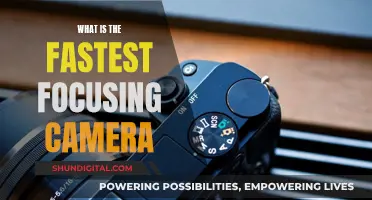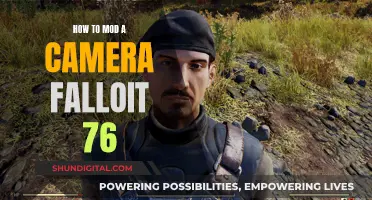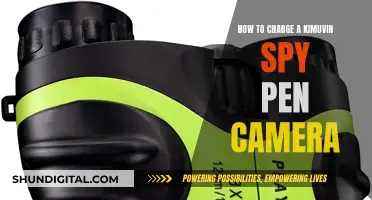
Camera angles are an essential aspect of visual storytelling, influencing how audiences perceive a scene and the emotions they experience. The angle of the camera can impact the relationships between subjects and between the audience and the subjects. For instance, a low-angle shot, where the camera is placed below the subject, can make the subject appear powerful and imposing, while a high-angle shot, taken from above, may convey vulnerability or weakness. Eye-level shots are the most common and create a sense of neutrality and naturalness. Additionally, tilted or dutch angles can evoke a sense of imbalance or psychological unrest. By understanding and manipulating camera angles, filmmakers and photographers can effectively convey narratives, evoke emotions, and guide the audience's interpretation of a scene.
| Characteristics | Values |
|---|---|
| Camera angle | High, low, eye-level, bird's-eye view, worm's-eye view, over-the-shoulder, point-of-view, dutch angle/tilted angle |
| Effect on viewer | Conveys emotion, vulnerability, power, dominance, superiority, weakness, intimacy, direct connection, neutrality, unnaturalness, instability, etc. |
| Effect on scene | Provides context, emphasises scale, shows relationship between subjects, establishes the landscape |
What You'll Learn

Camera angles can convey power dynamics
Camera angles are an essential tool for filmmakers and photographers to convey power dynamics between characters. By altering the angle of the camera, filmmakers can make their subjects appear powerful, weak, intimidating, inferior, vulnerable, or scary.
One commonly used technique is the low-angle shot, which involves positioning the camera below the eye level of the subject and tilting it upward. This technique can be used to create an illusion of power, authority, and dominance. It emphasises the size and stature of the subject, making them appear larger than life. For instance, in "The Lord of The Rings: The Fellowship of The Ring", Gandalf appears powerful and imposing as he stands before the hobbits, with the low angle exaggerating his height.
The low-angle shot can also evoke a sense of awe or intimidation, making the character seem more influential and even ruthless. In the Indian film "Sholay", the villain Gabbar Singh is filmed with a low-angle shot, enhancing his dominance and making him seem fearsome and ruthless.
The opposite of a low-angle shot is a high-angle shot, where the camera is placed above the subject and angled downwards. This technique can make characters seem small, weak, and vulnerable. In the film "Matilda", a high-angle shot is used to make the titular character appear extremely small, vulnerable, and lonely.
The choice between a low-angle and a high-angle shot can significantly impact the audience's perception of the scene and the characters. Low-angle shots can make the subject seem intimidating and imposing, while high-angle shots can emphasise a character's vulnerability or weakness.
Additionally, filmmakers can establish disproportionate power dynamics between characters by framing one character with a low-angle shot and the other with an eye-level shot. This technique can be used to great effect in dialogue scenes, subtly conveying the power imbalance between the characters through camera placement.
Charging Your Canon Camera Battery: A Step-by-Step Guide
You may want to see also

They can help viewers understand relationships
Camera angles play a crucial role in helping viewers understand the relationships between characters and between the audience and the characters. By altering the camera angle, filmmakers can establish different relationships between the subjects.
A high-angle shot, where the camera is positioned above the subject, can make the subject appear small, weak, or vulnerable. This angle can contribute to giving the audience a feeling of superiority over the characters. Conversely, a low-angle shot, captured from below the subject, can make the subject seem powerful, dominant, or imposing. This angle can evoke a sense of vulnerability in the viewer, as they are forced to look up.
An eye-level shot, where the camera is at the same height as the subject, creates a sense of neutrality and naturalness. This angle puts the audience on an equal footing with the characters, fostering a neutral relationship.
The Dutch angle, or tilted angle, is another effective way to convey relationships. By tilting the camera to the left or right, filmmakers create an unbalanced or unstable feeling, conveying a sense of psychological unrest in the viewer. This angle is often used when a character is experiencing something unusual or distressing, allowing the audience to share the character's perspective and feel their emotional state.
The choice of camera angle is essential in shaping the viewer's interpretation of the scene and their emotional response. By manipulating the angle, filmmakers can emphasise specific aspects of the narrative, such as the power dynamics or emotional states of the characters, thereby enhancing the storytelling and engaging the audience more deeply.
Finding the Battery Switch on Your Kidizoom Camera
You may want to see also

Angles can convey a character's feelings
Camera angles are an essential tool to convey a character's feelings in a film or photograph. By altering the camera angle, filmmakers can provide audiences with different perspectives, allowing them to understand the characters' emotions and experiences on a deeper level.
One way to convey a character's feelings is through the use of high and low camera angles. A high-angle shot, where the camera is positioned above the character, can make the subject appear small, weak, or vulnerable. This angle can suggest that something significant is happening above the character, enhancing their sense of insignificance. On the other hand, a low-angle shot, captured from below the character, can make them seem powerful, dominant, or intimidating. This angle can also evoke a sense of vulnerability in the viewer, as they are forced to look up, giving the character a "larger than life" presence.
The eye-level shot is another crucial angle to consider. This neutral shot, where the camera is level with the character's eyes, has little to no psychological effect on the viewer. It provides a natural perspective and is often used to establish a sense of comfort and neutrality. However, by slightly altering this angle, filmmakers can convey subtle feelings of unease or instability. For example, a dutch angle or tilted angle can evoke a sense of imbalance or psychological unrest, often used when a character is experiencing distress or something unusual.
Point-of-view (POV) shots are also powerful in conveying a character's feelings. By using a hand-held camera, filmmakers can create the illusion that the viewer is seeing through the character's eyes, fostering a sense of intimacy and direct connection. This technique allows the audience to experience the scene through the character's perspective, enhancing their understanding of the character's feelings and motivations.
Additionally, wide-angle shots and close-up shots can provide context and evoke emotions. Wide-angle views capture a broader scene, emphasising the scale and providing more context to the character's surroundings. In contrast, close-up shots focus tightly on the subject, highlighting fine details and intensifying the emotions conveyed.
By utilising these camera angles, filmmakers and photographers can effectively convey a character's feelings, creating a more engaging and immersive experience for the audience. These techniques showcase the importance of camera angles in visual storytelling, allowing viewers to interpret and connect with the characters on a deeper, more intuitive level.
Choosing a Camera: Capturing Nature and Cars
You may want to see also

They can make viewers feel a certain way
Camera angles play a crucial role in evoking certain emotions from viewers and influencing how they perceive the scene and the characters. A high-angle shot, for instance, can make the subject appear small, weak, or vulnerable. This angle is often used to suggest something significant is happening above the characters or to make them seem inferior. On the other hand, a low-angle shot, taken from below the subject, can make them seem powerful, dominant, or intimidating.
The eye-level shot, also known as a neutral shot, is when the camera is at the subject's eye level. This type of shot has little to no psychological effect on the viewer and is often used to establish a sense of neutrality and naturalness in the scene.
The bird's-eye view is a type of high-angle shot taken directly above the scene, usually to establish the landscape and the characters' relationship to it. This angle can create a sense of freedom or even omnipotence, as the viewer looks down on the scene from a superior position.
The Dutch angle, or tilted angle, is when the camera is tilted to the left or right, creating an off-kilter frame. This unnatural angle can evoke a sense of imbalance, instability, or psychological unrest in the viewer, often used when a character is experiencing something unusual or distressing.
The point-of-view (POV) shot is another powerful angle that creates intimacy and a direct connection with the viewer, making them feel as if they are seeing through the subject's eyes.
By choosing the right camera angle, filmmakers and photographers can effectively convey a narrative, influence the viewers' emotions, and enhance their overall experience.
Finding the Mode Button on the Hero 5 Camera
You may want to see also

Angles can be used to establish a scene
Camera angles are an essential aspect of visual storytelling, helping to establish the context, mood, and relationships within a scene. One of the most effective ways to use camera angles is to establish a scene and set the tone for the viewer.
A bird's-eye view or high-angle shot is captured from above and can be used to establish the landscape and the characters' relationship to it. This angle can evoke a sense of freedom or make the subject seem small, weak, or vulnerable. It can also contribute to a feeling of superiority over the scene, providing a unique perspective that gives the audience a sense of being in control.
On the other hand, a low-angle shot, captured from below, can make the subject appear more powerful, dominant, or imposing. This angle looks up at the subject, making it seem bigger and more intimidating. It can be used to make the viewer feel vulnerable and reinforce the strength or superiority of the subject or character.
The eye-level shot, also known as a neutral shot, is captured straight on or at the subject's eye level. This type of shot has little to no psychological effect on the viewer and is often used to establish a sense of comfort, neutrality, and naturalness. It is the most common camera angle used in films, as it provides a familiar and relatable perspective for the audience.
Additionally, wide-angle shots can be used to establish a scene by capturing a broader context and emphasising the scale of the environment. These shots provide more context and help viewers understand the relationship between the characters and their surroundings.
By choosing the right camera angle, filmmakers and photographers can effectively convey information, evoke emotions, and guide the audience's interpretation of the scene.
Mastering Camera Lock Mode: What, When, and Why?
You may want to see also
Frequently asked questions
Camera angles are important as they help convey a narrative and evoke thought, emotion, and psychological responses from viewers.
Camera angles can be used to manipulate the viewer's perception of the subject. A high-angle shot can make the subject appear small, weak, or vulnerable, while a low-angle shot can make the subject appear powerful, dominant, and imposing.
The most standard camera angle is the eye-level shot, where the camera is at the subject's eye level. This is a natural perspective for the viewer and can give a sense of neutrality and naturalness.
A bird's-eye view is a high-angle shot, capturing the scene from directly above. This angle can create a sense of freedom or omnipotence, providing a dramatically different perspective and establishing the landscape.
Camera angles can be used to establish different relationships between the viewer and the subject. For example, a low-angle shot can make the subject appear powerful and intimidating, while a high-angle shot can make the subject seem small and inferior. These angles can evoke feelings of vulnerability, dominance, or neutrality in the viewer.







